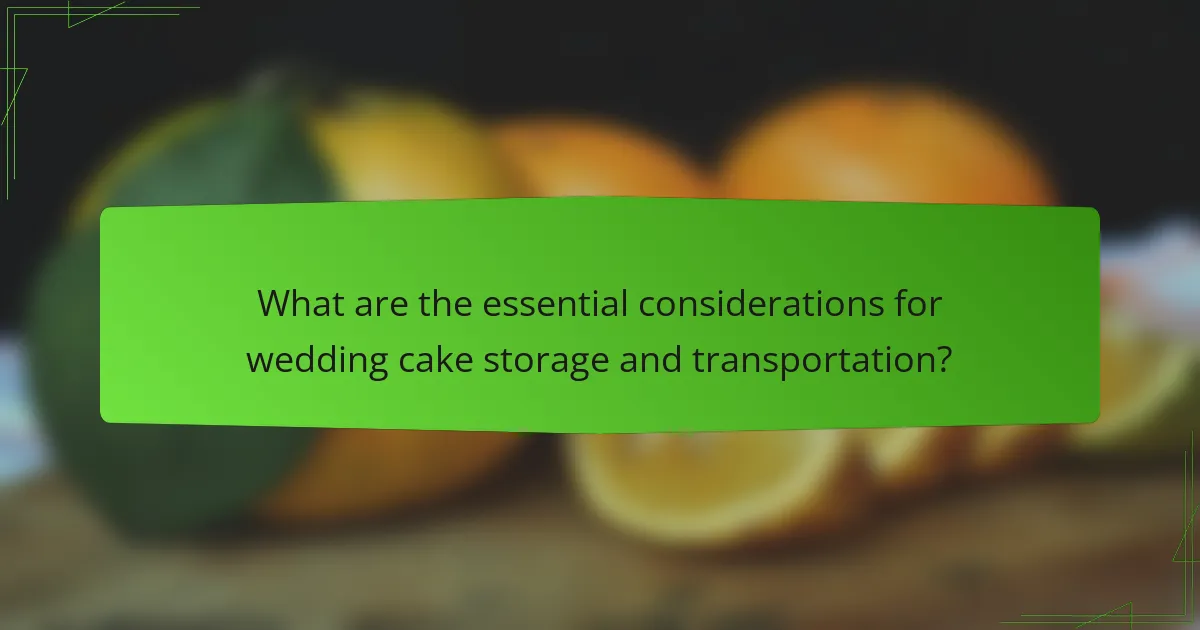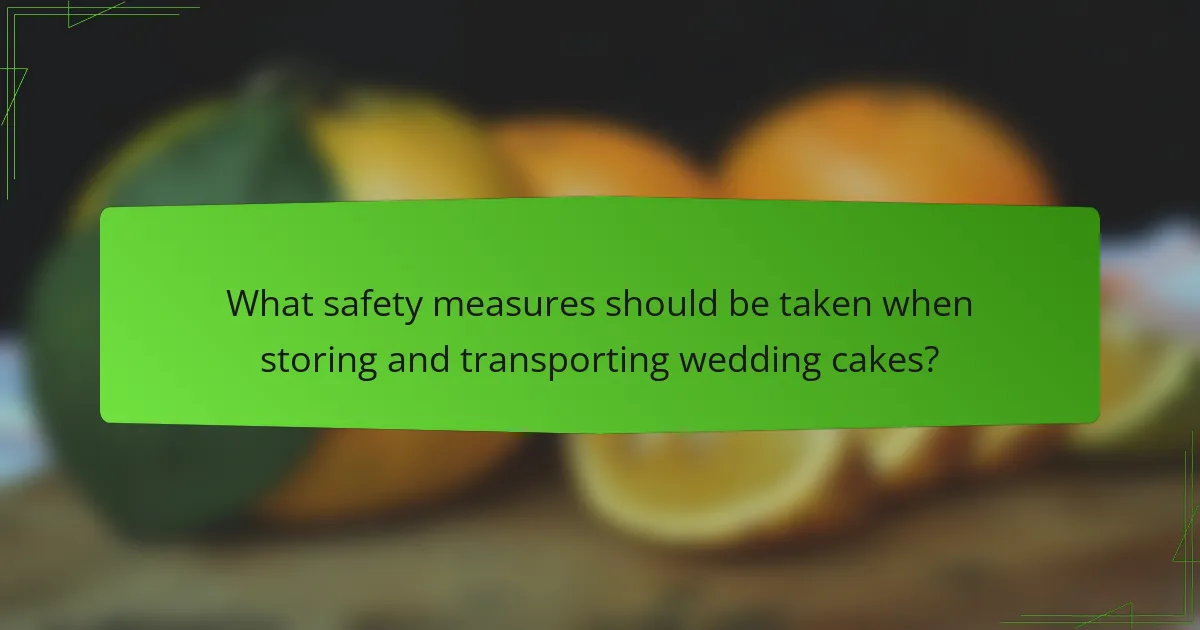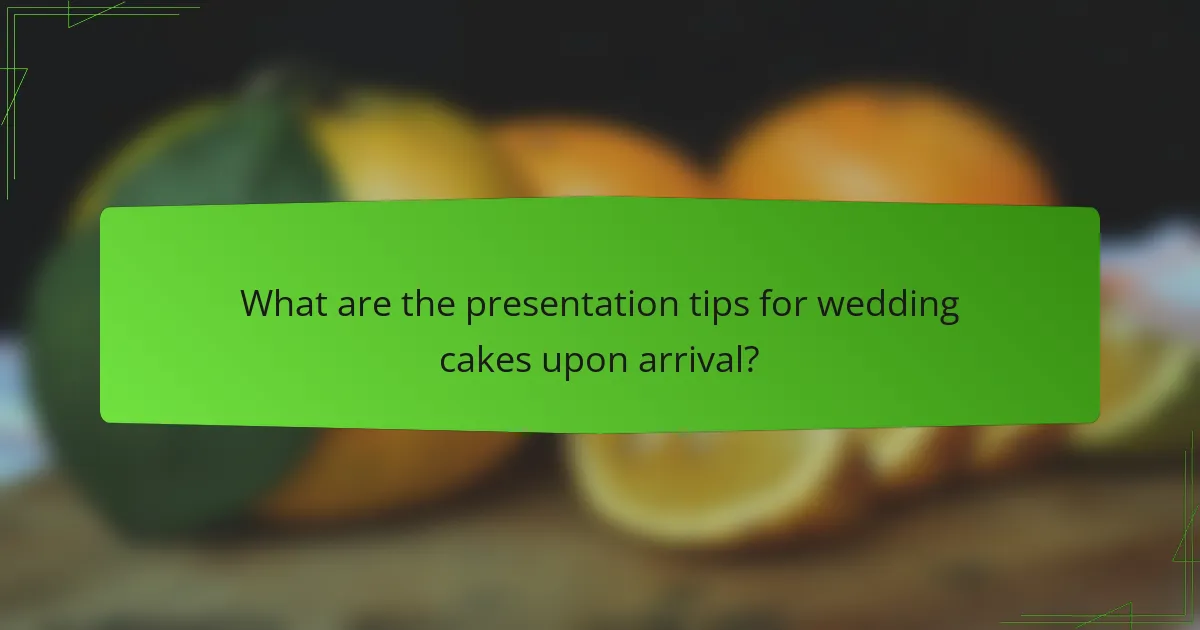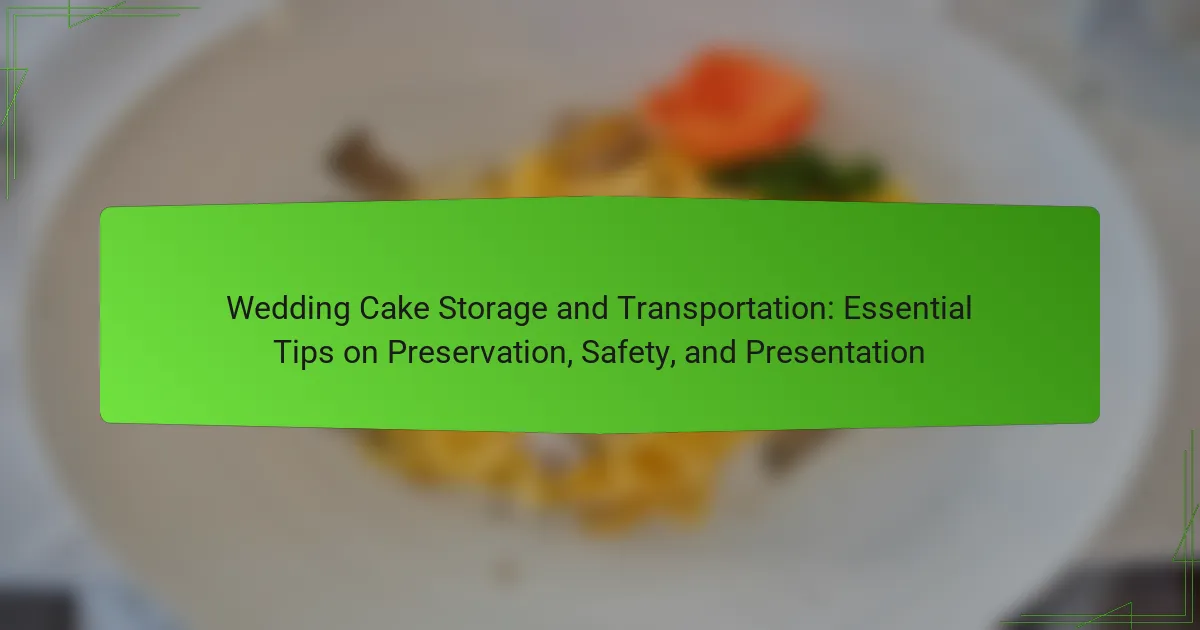
What are the essential considerations for wedding cake storage and transportation?
The essential considerations for wedding cake storage and transportation include temperature control, stability, and humidity. Wedding cakes should be stored in a cool environment to prevent melting or spoilage. Ideal temperatures are between 70°F and 75°F. Stability is crucial; cakes should be secured in a sturdy box to prevent movement. Using a non-slip mat can help keep the cake in place during transport. Humidity can affect the cake’s texture and appearance, so it’s important to avoid overly humid conditions. Transporting the cake in an air-conditioned vehicle can mitigate these risks. Additionally, it’s advisable to transport the cake upright to maintain its structure. Following these guidelines ensures the cake remains fresh and visually appealing upon arrival.
How does temperature affect wedding cake preservation?
Temperature significantly affects wedding cake preservation. High temperatures can cause cakes to melt, especially those with buttercream or fondant. Cakes stored in warm environments may also dry out or become stale faster. Conversely, refrigeration can help maintain freshness but may lead to condensation, affecting texture. Ideal storage temperatures range from 70°F to 75°F for most cakes. Studies show that cakes kept at these temperatures retain moisture and flavor better. Maintaining proper temperature is crucial for preserving the cake’s quality and appearance.
What is the ideal temperature range for storing wedding cakes?
The ideal temperature range for storing wedding cakes is between 68°F to 72°F (20°C to 22°C). This temperature helps maintain the cake’s freshness and texture. Storing cakes at this range prevents melting of frosting and structural damage. Refrigeration can dry out the cake, while higher temperatures may lead to spoilage. Many cake experts recommend this range for optimal preservation. Proper storage conditions can extend the cake’s shelf life significantly.
How can temperature fluctuations impact the cake’s quality?
Temperature fluctuations can significantly impact a cake’s quality. These variations can cause the cake to dry out or become overly moist. When a cake is exposed to high temperatures, the buttercream or fondant can melt, leading to structural instability. Conversely, low temperatures can cause the cake to harden and lose its intended texture.
Furthermore, temperature changes can affect the cake’s flavor. Ingredients like chocolate and fruit can react poorly to extreme heat or cold. This may lead to a less enjoyable taste experience. Maintaining a consistent temperature during storage and transportation is crucial for preserving the cake’s quality.
Studies indicate that cakes stored at stable temperatures retain their moisture levels better than those subjected to fluctuations. This highlights the importance of proper storage conditions for wedding cakes to ensure optimal quality.
What are the best practices for packaging a wedding cake for transportation?
The best practices for packaging a wedding cake for transportation include using a sturdy cake box. A box specifically designed for cakes provides support and protection. Ensure the cake is cooled completely before packaging. This prevents condensation and sogginess. Use a non-slip cake board underneath the cake for stability. Secure the cake with plastic wrap to prevent movement. Avoid stacking other items on top of the cake during transport. If needed, use dowels for multi-tiered cakes to maintain structure. Transport the cake in a flat, level space to avoid shifting. These practices help ensure the cake arrives intact and presentable.
What materials are recommended for wedding cake packaging?
Recommended materials for wedding cake packaging include sturdy cardboard boxes, plastic cake domes, and specialized cake boards. Cardboard boxes provide structural support and protect the cake during transport. Plastic cake domes offer visibility while safeguarding the cake from contaminants. Specialized cake boards ensure stable support for multi-tiered cakes. These materials help maintain the cake’s integrity and presentation. Proper packaging materials are essential for preventing damage and preserving freshness during transportation.
How can you secure the cake to prevent damage during transport?
To secure the cake and prevent damage during transport, use a sturdy cake box. A well-fitted box protects against movement and external pressure. Ensure the cake is placed on a solid base, like a cake board. This adds stability and prevents sliding. Use non-slip mats inside the box to minimize shifting. Secure the box with tape to keep it closed during transit. If transporting multiple tiers, consider using dowels for support. Avoid stacking cakes directly on top of each other without proper separation. Lastly, drive carefully to avoid sudden stops or sharp turns that could disturb the cake.
Why is proper transportation crucial for wedding cakes?
Proper transportation is crucial for wedding cakes to ensure their structural integrity and aesthetic appeal. Wedding cakes are often multi-tiered and intricately decorated. Any jostling or improper handling can lead to damage, such as collapsing layers or smeared frosting. Maintaining a stable temperature is also essential to prevent melting or warping. According to the American Cake Decorating Association, cakes can lose their form if exposed to extreme temperatures during transport. Additionally, proper packaging protects against external elements like dust and contaminants. Ensuring that a cake arrives intact is vital for the overall success of the wedding celebration.
What risks are associated with improper cake transportation?
Improper cake transportation can lead to structural damage, loss of decoration, and contamination. Cakes are delicate and can easily collapse if not properly supported. Uneven surfaces during transport can cause layers to shift or slide. This results in a visually unappealing product. Additionally, exposure to heat can cause melting of frosting and decorations. Contaminants can also enter the cake if it is not covered adequately. According to a survey by the American Bakers Association, 30% of cake damage occurs during transportation. Proper techniques are essential to mitigate these risks.
How can you minimize the risk of cake damage while traveling?
To minimize the risk of cake damage while traveling, use a sturdy cake box or carrier. A well-constructed cake box provides essential support and protection. Ensure the cake is placed on a flat, stable surface during transport. Avoid placing heavy items on top of the cake. If traveling long distances, consider refrigerating the cake beforehand to maintain its structure. Secure the cake with non-slip mats to prevent shifting. Choose a vehicle with a climate-controlled environment to avoid temperature fluctuations. Lastly, drive carefully to reduce sudden movements that could cause damage.

What safety measures should be taken when storing and transporting wedding cakes?
When storing and transporting wedding cakes, it is crucial to maintain their integrity and safety. Keep the cake refrigerated until just before transport to prevent melting. Use a sturdy cake box that is appropriately sized to avoid movement during transit. Secure the cake with non-slip mats or cake boards to prevent sliding. Ensure the vehicle used for transport is clean and free of strong odors. Avoid placing the cake in direct sunlight or near heat sources. If traveling long distances, consider using ice packs to maintain a stable temperature. Finally, always have a backup plan in case of emergencies, such as extra frosting or a small repair kit. These measures help preserve the cake’s quality and presentation during storage and transport.
How can you ensure food safety during cake storage?
To ensure food safety during cake storage, keep the cake in a cool, dry place. Store the cake in an airtight container to prevent contamination. If the cake contains perishable ingredients, refrigerate it. Maintain the refrigerator temperature at or below 40°F (4°C) to inhibit bacterial growth. Avoid leaving the cake out at room temperature for more than two hours. Use clean utensils when serving the cake to prevent cross-contamination. Regularly check for signs of spoilage, such as mold or off odors. Following these guidelines helps maintain the cake’s safety and quality.
What hygiene practices should be followed when handling wedding cakes?
Maintain strict hygiene practices when handling wedding cakes. Always wash hands thoroughly before and after touching the cake. Use clean utensils and surfaces to prevent contamination. Avoid touching the cake with bare hands to reduce the risk of transferring bacteria. Store the cake at the correct temperature to inhibit microbial growth. Ensure that any packaging used is sanitized before contact with the cake. Regularly clean and sanitize the work area to maintain a hygienic environment. These practices are essential to ensure food safety and prevent foodborne illnesses.
How can cross-contamination be avoided in cake storage?
Cross-contamination in cake storage can be avoided by using separate containers for different food items. Each cake should be stored in an airtight container to prevent exposure to contaminants. Additionally, clean utensils should be used when handling cakes to avoid transferring bacteria. It is important to store cakes away from raw foods, as these can harbor harmful pathogens. Regularly cleaning storage areas helps maintain a safe environment. Following these practices ensures that cakes remain safe for consumption.
What precautions should be taken during transportation to ensure safety?
Ensure proper temperature control during transportation to maintain cake integrity. Use insulated carriers to protect against heat or cold. Secure the cake in a stable position to prevent shifting. Avoid sudden movements or sharp turns while driving. Use non-slip mats to keep the cake from sliding. Ensure the vehicle is clean and free of odors that could affect the cake. Communicate with the delivery team about handling procedures. Follow these precautions to minimize the risk of damage during transport.
How can you prevent the cake from toppling over in the vehicle?
Secure the cake in a sturdy, flat box to prevent toppling during transport. Use non-slip mats or towels underneath the box for added stability. Position the cake on a flat surface in the vehicle, avoiding seats or areas that may shift. Ensure the vehicle is driven smoothly, avoiding sharp turns and sudden stops. Additionally, consider using cake supports or dowels inside the cake for extra stability. These methods significantly reduce the risk of the cake shifting or toppling during transportation.
What should you do if there is a delay in transportation?
If there is a delay in transportation, promptly communicate with the vendor or transportation service. This ensures they are aware of the situation and can provide assistance. Check the estimated time of arrival for the transportation. Monitor the cake’s condition to prevent damage or spoilage. If possible, keep the cake in a cool, stable environment. Avoid opening the cake box frequently to maintain its integrity. Document any issues for future reference and resolution. These steps help ensure the cake remains safe and presentable despite transportation delays.

What are the presentation tips for wedding cakes upon arrival?
Ensure the wedding cake is placed on a sturdy, level surface upon arrival. Use a cake stand that complements the design for better visual appeal. Keep the cake covered until it is time for the presentation to maintain freshness. Remove any packaging carefully to avoid damage. Decorate the surrounding area with complementary flowers or candles for added elegance. Use a cake server that matches the theme for serving. Ensure the cake is at the appropriate temperature before display. Position the cake in a well-lit area to enhance its features and colors.
How can you enhance the visual appeal of the wedding cake at the venue?
To enhance the visual appeal of the wedding cake at the venue, use decorative elements that complement the overall theme. Incorporate fresh flowers that match the wedding color palette. Utilize elegant cake stands to elevate the cake, providing height and dimension. Add edible gold or silver leaf for a luxurious touch. Include intricate piping or fondant designs for added detail. Arrange ambient lighting around the cake to highlight its features. Display the cake on a beautifully decorated table with coordinated linens and decor. Each of these methods contributes to a visually stunning presentation.
What decorative elements can be added to the cake for presentation?
Decorative elements that can be added to a cake for presentation include fresh flowers, edible glitter, and fondant decorations. Fresh flowers provide a natural and elegant look. Edible glitter adds sparkle and visual appeal. Fondant decorations can be shaped into various designs, enhancing the cake’s theme. Other options include fruit, chocolate curls, and piping. Fruit adds color and freshness. Chocolate curls contribute a luxurious texture. Piping can create intricate designs, showcasing craftsmanship. These elements not only enhance aesthetics but also reflect the occasion’s theme.
How should the cake be displayed for optimal effect?
The cake should be displayed on a sturdy, elevated cake stand. This enhances visibility and creates a focal point for guests. Use a decorative stand that complements the wedding theme. Ensure the cake is centered on the stand for balance. Surround the cake with fresh flowers or greenery for added appeal. Utilize good lighting to highlight the cake’s details. Avoid clutter around the display area to maintain focus on the cake. A clean, simple backdrop can enhance the overall presentation.
What are the common troubleshooting tips for wedding cake issues during transportation?
To address common wedding cake issues during transportation, secure the cake in a stable, flat surface. Use a cake box or a non-slip mat to prevent movement. Ensure the cake is well-cooled to avoid melting. For multi-tier cakes, support each layer with dowels. Avoid sudden stops or sharp turns while driving. Keep the cake in a climate-controlled environment to maintain integrity. If the cake shifts, reassemble it at the venue. These practices help maintain the cake’s appearance and structure during transport.
How can you fix minor damages that occur during transport?
To fix minor damages that occur during transport, assess the damage immediately. For small dents or cracks, use a small amount of frosting to fill in gaps. Smooth the frosting with a spatula for a seamless appearance. If decorations are dislodged, reattach them carefully using frosting or edible glue. For minor smudges on the frosting, gently wipe with a clean, dry cloth. If the cake has shifted, reposition it carefully to restore its original shape. These methods ensure the cake maintains its presentation after transport.
What steps should be taken if the cake arrives in poor condition?
If the cake arrives in poor condition, first inspect the cake for damage. Check for any visible signs of spoilage or structural issues. Take clear photographs of the cake to document its condition. Contact the bakery or vendor immediately to report the issue. Provide them with the photographs and details of the damage. Request a replacement or refund based on their policy. Keep the cake stored safely until a resolution is reached. Following these steps ensures proper handling and accountability.
Wedding cakes are intricate creations that require careful storage and transportation to maintain their quality and appearance. This article provides essential tips on temperature control, stability, and humidity management, emphasizing the ideal conditions for preserving wedding cakes. It covers best practices for packaging and securing cakes during transport, as well as safety measures to prevent contamination. Additionally, the article discusses presentation techniques to enhance the visual appeal of the cake upon arrival at the venue, ensuring it remains a focal point of the celebration.
